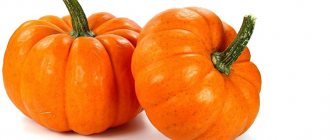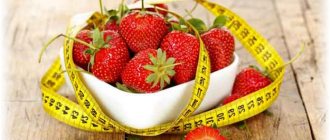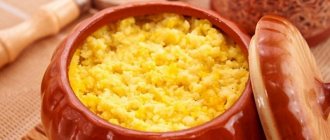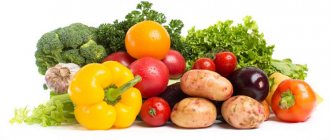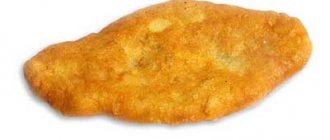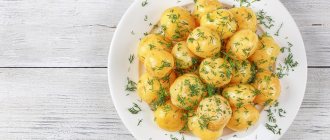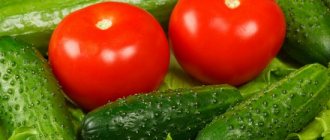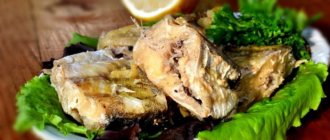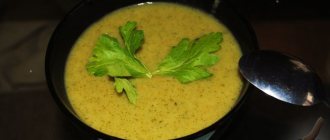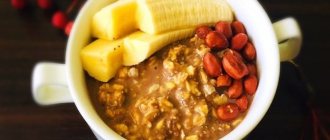© LMproduction – stock.adobe.com
Share:
Pumpkin is a healthy and tasty vegetable that is eaten in a wide variety of forms. Thanks to its chemical composition, pumpkin is extremely popular among those who are on a diet or simply stick to proper nutrition, and for athletes this vegetable is a godsend. Pumpkin pulp is quickly digestible, which allows you to eat it at almost any time of the day. However, this melon crop also has contraindications for use.
In the article we will look at who can eat pumpkin and who is strictly not recommended, and find out what useful substances this melon crop is rich in.
Compound
Everyone is confident in the low calorie content of zucchini.
But this is the closest relative of the pumpkin. For clarity, let’s compare the calorie content and nutritional value of both vegetables. The table shows their chemical composition: it is a low-calorie product; The composition of pumpkin and its comparison with zucchini allows us to draw the following conclusions:
- 100 grams of pumpkin contains more protein, but less fat and carbohydrates than zucchini;
- it contains a lot of dietary fiber (pectin, fiber), which makes the vegetable filling and beneficial for digestion;
- There are relatively few saccharides, it is even recommended for diabetes;
- both vegetables contain very few organic acids, so they are allowed even during inflammatory processes in the digestive organs;
- like in zucchini (and in cucumbers too), the pumpkin contains more than 90% water.
Add to this an abundance of vitamins, macro- and microelements. The leader among vitamins is vitamin C (per 100 g – 15 mg). The vegetable is rich in beta-carotene, thiamine, riboflavin, folic and nicotinic acid, biotin, etc. It contains a lot of potassium, so it is recommended for diseases of the cardiovascular system and edema. Pumpkin will enrich the body with calcium, magnesium, sodium, iron, phosphorus and cobalt.
100 grams of pumpkin cover 6.7% of the daily requirement for dietary fiber, 5% for organic acids; 8% is in vitamin B3, 8.9% is in C, 8.2% is in potassium and 10% is in cobalt.
Take full advantage of the unique properties of the vegetable by arranging fasting days with it. 1.5 kg of pumpkin should be baked in a heated oven for 10 minutes to make it softer. This way it is better absorbed. Divide the daily dose into several doses.
How many calories are in stewed pumpkin?
The calorie content of pumpkin stewed in water is approximately equal to the calorie content of steamed pumpkin, and is about 30 kcal per 100 g. At the same time, in its pure form the product is not very tasty and is used as part of more complex dishes.
For one of the recipes you will need:
- 400 g pumpkin;
- 4 cloves of garlic;
- 150 ml fat sour cream;
- 50 g parsley;
- a little vegetable oil;
- salt and pepper.
Peel the pumpkin, cut into large pieces and fry until golden brown in a frying pan.
Chop the parsley and pass the garlic through a press. Mix sour cream with garlic and parsley, add salt and pepper, and then mix well. Add the sauce to the pumpkin in the pan, stir and simmer, covered, for 10 minutes until the cubes soften.
Crush the walnuts and sprinkle them over the pumpkin before serving. You can stew pumpkin in many other ways, and the calorie content of a particular dish is 189 kcal per 100 g.
Here are a couple more interesting ways to stew pumpkin with milk and sugar syrup
Pumpkin stewed with sugar
The recipe requires 1.5 kg of pumpkin, 500 g of sugar and water. Select the seeds from the pulp and cut it into 3 cm cubes, and then place it in a saucepan, pouring 2 cm of water into it.
Add half the sugar and simmer over low heat, covered, for half an hour, then drain the juice and add the remaining sugar. Continue to simmer for another hour, then remove the lid, increase the heat and evaporate the juice. The calorie content of pumpkin stewed with sugar according to this recipe is 160 kcal per 100 g.
To prepare the dish you will need the following ingredients:
- 800 g pumpkin;
- 2 tablespoons flour;
- 1.5 glasses of milk;
- spoon of sugar;
- vegetable oil.
Peel the pumpkin and remove the seeds from the pulp, then boil it in lightly salted water and dry it. Fry the flour and dilute it with hot milk, and then add sugar to it. Pour this mixture over the pumpkin and bring to a boil. The dish is ready and can be served.
The calorie content of pumpkin boiled with milk is approximately 200 kcal per 100 g. It depends on the amount of sugar and the fat content of the milk used.
Calorie content of pumpkin dishes
Convincing information about the vegetable as a dietary and “correct” product concerns only raw pumpkin.
How do calorie content and its composition change depending on the cooking method? Over the long history of pumpkin’s popularity, many recipes have accumulated. Their calorie content per 100 grams is shown in the table:
As you can see, there are few calories in pumpkin dishes. Meanwhile, its unusual taste will diversify the traditional menu and make it much healthier.
Raw pumpkin
Pumpkin pulp is good to eat raw. All the benefits are preserved in it and the calorie content is low. For this purpose, choose sweet nutmeg varieties. Peel the fruits from the dense peel and seeds, cut into cubes - the fragrant, juicy fruits are ready. You can prepare dietary but satisfying salads - with apples, nuts, vegetables, cheese, etc.
Boiled pumpkin
This is a light product, easy to prepare.
You need to cook the peeled pieces for no more than half an hour. If they seem too bland, you can dust them with sugar and cinnamon. But the calorie content of such a dish will increase significantly - from 37 to 127 calories per 100 grams. If you grind a boiled vegetable in a blender, you get a tasty puree. Pumpkin puree is one of the first baby foods. Its taste is richer and not as bland than that of zucchini puree.
Baked pumpkin
You can make a delicious low-calorie dessert from baked vegetables. A popular recipe is with honey, apples and orange. Peel a kilogram of pumpkin and 2 apples, cut them into cubes, squeeze orange juice on them and add 2 tbsp. honey
Baking is another way to prepare vegetable fruits. Baked pumpkin is a frequent guest on the table of those losing weight due to its low calorie content and good digestibility. To make it soft, you need to bake it in foil for 20 minutes.
Stewed pumpkin
This can be an excellent side dish for meat or fish. A tasty vegetable, the calorie content of which when stewed does not exceed 60 calories, is an excellent alternative to potatoes. But remember that additional ingredients (butter, milk) sharply increase the calorie content of the dish.
How many calories are in raw pumpkin?
Pumpkin consists of 90% water, so it is considered a dietary product. The small content of coarse dietary fiber and organic acids in the pulp makes it useful for inflammation of the stomach and intestines, and it can also be eaten for iron deficiency anemia and many other ailments. The calorie content of fresh pumpkin in its raw form is only 28 kcal per 100 g.
Read also: Do-it-yourself poultry plucking machine video
Let's take a closer look at the most popular varieties of pumpkin: butternut and nutmeg.
A pumpkin variety called butternut was artificially bred in 1960 in America by crossing wild African and nutmeg varieties. The key feature of butternut squash is the rapid ripening of the pumpkin - within 3 months from the moment of planting.
Butternut squash is very common in cooking because it has a pleasant nutty flavor and buttery texture. The product can be stored for a long time at room temperature, and it can be prepared in different ways: boiling, stewing, frying, baking, etc. The calorie content of butternut squash does not exceed 45 kcal per 100 g.
Butternut squash is a separate variety that is considered the most delicious of all. It was bred in Mexico, so the crop turned out to be heat-loving and long-ripening, unlike other varieties. In our country, nutmeg pumpkin is grown only in the southern regions.
The vegetable is distinguished by its elongated oblong shape and yellowish-brown color. The peel is quite thin and can be easily removed with a sharp knife. The pulp has a bright orange color and a pleasant nutmeg aroma. The calorie content of butternut squash is approximately 45 kcal per 100 g.
In cooking, this variety of pumpkin is used both raw and after heat treatment. It is suitable for preparing salads, stewed and fried dishes, used as a filling for pies and pancakes, etc.
Calorie content of pumpkin seeds
If the taste of the pumpkin itself seems unusual to some, then everyone usually loves the seeds. Moreover, they are recommended as a natural medicine for diseases of the cardiovascular and digestive systems. Pumpkin seed fiber cleanses the body and saturates it well. And its anthelmintic properties are known to everyone. But do lovers of pumpkin delicacy know that its calorie content is very high? Due to the oils contained in 100 grams of seeds - 556 calories! Therefore, pumpkin seeds, the benefits and harms of which are inseparable, should be consumed with caution by those on a diet. Like nuts, you can eat a lot of them.
A vegetable with a bright appearance has a bright taste. Decorate not only your home with it, but also the healthy menu of your loved ones.
What are the benefits of pulp?
The benefits of pumpkin for the body of every person are enormous, because this fruit is a real storehouse of useful substances, thanks to which it has valuable properties:
- Pumpkin fruit is good for the digestive system. Having a high fiber content, it greatly facilitates digestion.
- Improves vision. In order to have good vision for as long as possible, the body needs vitamin A, or, in other words, carotene. Despite the fact that its content in pumpkin is less than in carrots, the former is still beneficial for the human eye.
- Leader in the content of vitamin T, which is responsible for blood clotting. Due to the high content of this vitamin, pumpkin improves metabolism.
- Indispensable for people suffering from hypertension, as it has pectin fibers, which are indispensable in the fight against toxins, cholesterol and waste. Pumpkin juice helps normalize blood pressure and strengthen the walls of blood vessels. Used to prevent tuberculosis and pyelonephritis.
- Pumpkin preparations do not contain toxic substances, which allows them to be prescribed for the treatment of young children and the elderly, since they do not harm the body.
- Useful for people with kidney and bladder problems, as it has a mild diuretic effect.
- Helps fight insomnia.
- Useful for constipation and used as a laxative.
- Strengthens the body's protective functions.
- Has an anti-inflammatory effect. Used to eliminate the inflammatory process in the intestines. Also used externally, for example, for burns, eczema and wounds.
- Rejuvenates the body. This effect occurs due to the fact that pumpkin provokes tissue regeneration and faster cell renewal.
- Used for cosmetic purposes as part of masks.
Baked, raw, boiled pumpkin remains tasty and healthy in any form.
Pumpkin
Pumpkin (Cucurbita) is an annual or perennial herbaceous plant, a melon crop of the Cucurbitaceae family. Pumpkin was first cultivated in South America more than 8 thousand years ago; the vegetable appeared in Europe in the 16th century thanks to Spanish sailors. Pumpkin fruits have a round, oval or flattened shape; decorative pumpkins can come in a wide variety of bizarre shapes. Pumpkins are also heterogeneous in color - bright red or dark green, with or without stripes, variegated and pastel olive, it all depends on the variety. The weight of pumpkin fruits can reach 200 kg, but the weight of an ordinary pumpkin is from 2 to 9 kg. Due to the fact that pumpkin can retain its taste and beneficial properties for up to six months, without requiring special storage conditions, almost all gardeners enjoy growing the vegetable.
Calorie content of pumpkin
The calorie content of pumpkin is 28 kcal per 100 grams of product.
Composition and beneficial properties of pumpkin
The chemical composition of pumpkin contains a large number of useful minerals and vitamins. The vegetable contains: beta-carotene, vitamins B1, B2, C, E, PP, as well as minerals necessary for the body: potassium, calcium, magnesium, zinc, fluorine, copper and manganese, iron, cobalt, phosphorus and sodium.
Pumpkin is a godsend for people suffering from diseases of the cardiovascular system and gastrointestinal tract, due to potassium, which maintains the tone of the heart muscle and the low content of coarse dietary fiber, which irritates the digestive tract.
Pumpkin is a dietary product, so it can be eaten for gastritis and stomach ulcers. The product is able to delay the aging process and has a beneficial effect on the condition of the skin and hair.
In addition to the pumpkin itself, pumpkin seeds are very useful as a preventative against helminths and pumpkin juice, which is involved in hematopoiesis.
Varieties and types of pumpkin
Pumpkins are divided into early-ripening, mid-ripening, late-ripening and early-ripening; hard-barked, large-fruited and nutmeg; fodder (for livestock feed only), table (for human food) and decorative (for decoration).
The most common varieties of pumpkin, unpretentious and growing well in the middle zone: Rossiyanka, Zorka, Acorn, Mramornaya, Gribovskaya, Almondnaya, Mozoleevskaya, Zimnyaya Sladkaya, Khersonskaya, Ulybka, Butternut, Arina. Not the best land is suitable for growing pumpkins; it is convenient to plant pumpkins in compost pits, along fences; large leaves and fruits will decorate any corner of your summer cottage. Decorative pumpkins are beautiful not only in compositions, but also during growth; they are usually planted next to gazebos or playgrounds.
Pumpkin and weight loss
Having low calorie content, a sufficient amount of fiber and a pleasant taste, pumpkin is one of the favorite foods for fasting days and diets. A big plus of pumpkin is its cheerful red color, which lifts your spirits and makes it easier to cope with food restrictions.
Pumpkin in cooking
Pumpkin is subjected to all types of heat treatment - it is boiled, fried, baked and grilled. Soups and porridges, preserves and jams are made from pumpkin, baked with meat and stewed in stews, added to dough for pancakes, muffins and pies, fillings for cakes, it goes well with cottage cheese. Raw pumpkin is used in salads with apples and carrots, and eaten dipped in honey as a dessert. Pumpkin dishes are very tasty and extremely healthy.
Pumpkin and Halloween
The most memorable symbol of Halloween - a cheerful holiday on the eve of All Saints' Day, celebrated on the night of November 1st - is considered to be the Jack-o'-lantern, which is a hollow pumpkin with cut-out eyes and an ominous grin in which a candle is placed. Initially, such lamps were made from turnips in the homeland of Halloween - in Scotland and Northern Ireland, but at the turn of the twentieth century the holiday migrated across the ocean to America, where turnips were replaced by pumpkins, which were cheaper and more accessible (calorizator). The purpose of Jack-o'-lanterns is to drive away the souls of the dead who return before All Saints' Day from the house.
Nowadays, Halloween is a reason to meet with friends, dress up as horror movie characters and work on a big pumpkin so that Jack-O-Lantern will remind you of a great time for a long time.
You can learn more about pumpkin and its beneficial properties from the video clip of the TV show “About the Most Important Thing,” starting at 16 minutes 07 seconds.
Benefits of pumpkin for humans
Pumpkin is especially useful for the female body. A large amount of vitamin E has a beneficial effect on skin, nails and hair. Gynecologists recommend eating autumn vegetables to increase the chances of pregnancy, since vitamin E is involved in the formation of new healthy cells. But for those who have already experienced menopause, pumpkin will be a good antidepressant that will help get rid of unpleasant feelings during this period.
Pumpkin retains its beneficial properties after baking, boiling or steaming.
Not only the pulp of the pumpkin is edible, but also the seeds. They are high in magnesium, zinc and protein. But the energy value of the seeds is much greater than that of the pulp. 100 g of seeds contain 556 kcal, so they should be introduced into your diet carefully. For example, they make oil that can be added to salads; in this form, this product will be more beneficial.
Many men are also interested in the benefits of pumpkin. The stronger sex should pay attention to the seeds, since they contain a lot of zinc, and it is he who is involved in the production of testosterone. Regular consumption of pumpkin seeds protects men from prostatitis. Men should also drink pumpkin juice, as it is very restorative. This is a great option to refresh yourself after a hard workout.
The benefits of pumpkin for the human body are as follows:
- It has a diuretic effect (you remember that it is 90% water), which helps people who suffer from kidney problems. Raw pumpkin is recommended for use by people with kidney failure, as well as for the prevention of tuberculosis.
- Since pumpkin is a strong antioxidant, it is useful in preventing any pathogenic processes at the cellular level.
- For those who are obese or struggling with excess weight, pumpkin is a real godsend, as it helps digest foods faster.
- With constant consumption of pumpkin pulp, blood pressure normalizes. For people who play sports (active fat-burning workouts, which lead to increased blood pressure, are especially popular now), a few pieces of pulp will help normalize blood pressure levels.
- Although pumpkin does not have much vitamin A, it also has a beneficial effect on vision.
- Pumpkin is high in vitamin C, which supports the immune system. With the onset of autumn, try to eat vegetables as often as possible - you will get sick less.
Scientists have noticed that regular consumption of this autumn beauty normalizes sleep, so those who suffer from insomnia should definitely introduce pumpkin into their diet.
This melon crop has a good effect on the gastrointestinal tract (gastrointestinal tract). Therefore, people who suffer from constipation are recommended to make themselves a paste from fresh pumpkin. This treat is eaten for breakfast and better on an empty stomach. You shouldn’t worry about stomach discomfort; there won’t be any, since pumpkin is easily and quickly digested (it doesn’t matter whether it has been heat-treated or not). Also, raw pumpkin will benefit those who have liver problems - only in this case it is better to eat it for lunch or dinner.
Human health is a complex mechanism that needs to be carefully monitored, and pumpkin is an excellent assistant in this matter. If this vegetable is constantly in your diet, your well-being will improve, and your systems and organs will function without failure.
Since pumpkin is a gift of autumn, it does not grow all year round. But it can be prepared, for example, by freezing it in pieces or placing it whole in a cold and dark cellar. Pumpkin has excellent shelf life and the ability to be transported over long distances.
The benefits and harms of boiled pumpkin: what is good about a boiled vegetable, how to properly prepare and eat it
Pumpkin enjoys well-deserved popularity on all continents. They cook it in different ways: boil it, bake it, stew it, eat it raw, prepare snacks, season it with spices, herbs, butter and honey. It is useful in any form for adults and children.
Of course, the maximum benefit can be obtained from the raw pulp, but the cooked vegetable also contains the same minerals and vitamins. In this article we will talk about the benefits and harms of boiled pumpkin, consumption rates and contraindications.
Harm
Although dietary fiber provides a number of benefits, it is best to eat the vegetable in moderation as there are some side effects of consuming too much fiber. Side effects of overeating:
May lead to weight gain. Although the vegetable is very healthy when it comes to weight loss, you should also remember that preserves, jams and jellies contain sugar and calories, which can lead to weight gain. If you want to enjoy pumpkin smoothies, make sure there is no sugar, otherwise your weight loss plan will go downhill. Pumpkin seeds provide numerous health benefits and are also a major contributor to weight gain. This is due to their high absorption capacity.
Harm to the digestive system. Some of the major side effects of overeating dietary fiber are malabsorption, abdominal pain, irregular heartbeat, indigestion, intestinal gas, and bloating. Therefore, it is better to eat pumpkin in moderation.
Moderate with diabetes. Although pumpkins are very effective in fighting diabetes, it is best to eat them in moderation as too much will lower your blood sugar levels to dangerously low levels, causing hypoglycemia.
Moderate when using medications. Also, if you are a diabetic patient and already taking medication, including too much of the vegetable in your diet may interfere with your treatment and may cause your blood sugar levels to drop - this is dangerous. If a person suffers from hypertension and is taking medication, then eating too much pumpkin along with the medication will cause hypotension. If you are taking medication, it is best to consume pumpkin in moderation and only as recommended by your doctor.
May cause hypotension. Although pumpkins are very effective in fighting high blood pressure, it is best to eat them in moderation because consuming too much can lower your blood pressure to dangerously low levels.
Excessive consumption of antioxidants. Although antioxidants provide many benefits, it is still best to eat them in moderation as there are some side effects of overdosing. At regular levels, antioxidants protect our cells from free radicals and reduce the risk of cancer. However, at higher levels, these antioxidants may even promote the development of cancer cells.
Use in moderation during pregnancy and lactation
Pregnant and nursing mothers should use pumpkin with caution. Pregnancy and the period of child care is a decisive step in the life of every woman.
It is necessary to eat food that is safe for the child’s health. It is better to consume pumpkin in moderation and only on the recommendation of a doctor. If you are taking any medications, discuss with your doctor and make sure that eating the vegetable will not interfere with your treatment.
Allergic reactions. The vegetable can cause allergic reactions such as itching, dermatitis, nasal congestion, difficulty breathing, shortness of breath, swelling of the lips and face. These people should avoid the vegetable completely, as even if pumpkin or seeds come into contact with the skin, an allergic reaction can occur.
Boiled pumpkin
Pumpkin is a valuable melon crop with a rich chemical composition. It is very easy to prepare at home. Boiled pulp makes excellent porridges, soups, and purees for baby food. The advantage of this method of culinary processing is the preservation of the beneficial qualities inherent in the raw vegetable.
Benefits and harms
Pumpkin contains a lot of useful elements that have a beneficial effect on all systems of the human body.
Vitamin T, which is found in large quantities in pumpkin, helps digest meat, legumes, and vegetables with a high content of coarse fiber.
Copper, iron, calcium, cobalt and zinc increase hemoglobin, strengthen bones, and strengthen the immune system.
Fiber accelerates the elimination of toxins and cholesterol and helps reduce excess weight.
Boiled pumpkin is suitable for baby food from an early age. The bright orange shade attracts the attention of little ones. Mashed potatoes, cereals and soups are often liked by little picky eaters. They perfectly saturate and replenish vitamins and minerals.
Boiled pulp helps pregnant women fight edema. This is facilitated by potassium, which gently and safely removes excess fluid from tissues.
Boiled pumpkin masks can replace many expensive cosmetic products. They fill the skin with moisture, nourish, vitaminize and smooth out the network of fine wrinkles.
In addition to its beneficial effects on the body, boiled pumpkin can harm people suffering from:
- diabetes mellitus (the pulp contains a lot of sucrose and fructose, which lead to sharp jumps in insulin);
- ulcerative lesions of the gastrointestinal tract in the acute stage;
- chronic diarrhea (pumpkin has a laxative effect).
Reference . The ban on pumpkin for stomach ulcers applies more to the raw vegetable. Boiled pulp is allowed to be consumed in small quantities.
Compound
The pulp of boiled pumpkin contains almost the same nutrients as the raw vegetable:
- vitamin A - useful for myopia, supports healthy teeth, skin, nails and hair;
- B vitamins - normalize sugar levels, strengthen the immune system, increase resistance to stress, improve the functioning of the digestive tract;
- vitamin D - forms and strengthens bones, inhibits the development of cancer cells, invigorates;
- vitamin K - prevents the leaching of minerals from bones;
- vitamin PP - normalizes the state of the nervous system;
- Vitamin T - helps digest food;
- iron - increases hemoglobin;
- magnesium - regulates the functioning of the heart muscle;
- cobalt - responsible for hematopoiesis;
- zinc - rejuvenates, relieves inflammation of the prostate gland, relieves sexual dysfunction;
- copper - helps the body absorb iron.
KBJU and glycemic index
Nutrients:
- proteins – 1 g;
- fats – 1 g;
- carbohydrates – 4.4 g.
How many calories are in boiled pumpkin? Per 100 g of pulp - only 28 kcal.
Glycemic index of boiled pulp is 75 units. This is a fairly high figure, so diabetics are advised to consume pumpkin in limited quantities. For them, the beneficial effect of pumpkin on the pancreas is especially noteworthy.
Reference .
The glycemic index (GI) is an indicator that displays the rate at which blood sugar levels increase when specific foods are consumed. The body absorbs fast carbohydrates quickly. The jumping glucose level signals the pancreas to produce a portion of insulin.
Beneficial features
Pumpkin truly has incredible healing properties due to its composition, namely:
- has a beneficial effect on the intestinal microflora;
- stimulates the functioning of the entire gastrointestinal tract;
- prevents the absorption of fat-containing components;
- regulates blood cholesterol levels;
- helps cure stomach ulcers;
- helps with diseases of the genitourinary system, as it acts as a good diuretic;
- helps with liver and kidney diseases;
- removes toxins and waste, cleanses the stomach and tones the body;
- fights tuberculosis;
- helps improve the condition of hepatitis and cirrhosis of the liver;
- helps with insomnia, relieves anxiety;
- useful for men with sexual dysfunction;
- strengthens the immune system;
- helps to lose weight;
- for women it has a beneficial effect on the cervix;
- can improve the condition of infertility, female inflammation, cervical erosion;
- useful for pregnant women;
- useful for women during menopause - improves the condition during this period.
Benefits for various diseases
Boiled pumpkin is recommended to be included in the menu for the following diseases:
- gout;
- atherosclerosis;
- pathologies of the intestines, kidneys, liver, gall bladder;
- constipation;
- diabetes;
- obesity;
- skin lesions (dermatitis, eczema);
- diseases of the heart and blood vessels.
When losing weight
Low calorie content, high fiber and pectin content help you easily lose weight and remove excess water, which delays the weight loss process.
Pumpkin pulp increases intestinal contraction and helps eliminate “bad” cholesterol. Coarse fiber, moving through the digestive tract, cleanses the walls of waste and toxins.
Just replace starchy vegetables with boiled pumpkin during your weight loss period, lose weight easily and without failure.
For men
Zinc in the pulp regulates the production of testosterone, improves the quality of seminal fluid, prevents the development of prostatitis, and eliminates problems with urination.
For women
The vegetable is also useful for females. Due to the high content of carotenoids, pumpkin provides an even tan and improves complexion, helps remove deposits in fat traps (sides, hips, back). During menopause, it prevents the development of complications (cardiac dysfunction, osteochondrosis due to a decrease in estrogen).
Folic acid, calcium and phosphorus support a woman’s body during pregnancy and contribute to the full development of the fetus.
Vitamin E reduces the risk of gynecological diseases.
For children
100 g of boiled pumpkin puree contains the daily requirement of beta-carotene for children. The vitamin is necessary to maintain visual function, bone mineralization, and improve immunity.
Pediatricians recommend introducing pumpkin into the diet of hyperactive children. The minerals and vitamins it contains have a beneficial effect on sleep, calm the nervous system, and increase perseverance and attentiveness.
Pumpkin and its glycemic index
The glycemic index is a relative indicator that characterizes the rate at which carbohydrates are absorbed by the body and their effect on changes in blood glucose levels.
Carbohydrates received by the body along with food are the main source of energy to maintain its vital functions. The molecules of these components have a simple structure, so they are quickly absorbed by the body.
This causes a sharp increase in blood sugar levels and provokes the release of insulin, which regulates the functioning of the pancreas. Carbohydrates belong to the group of monosaccharides.
We recommend that you familiarize yourself with Sage, an assistant for menopause and hot flashes
Monosaccharides are found in sweets, baked goods, pasta, and carbonated drinks.
Excessive consumption of these products may lead to adverse effects:
- persistent feeling of hunger;
- wear and tear of blood vessels and pancreas;
- risk of diabetes.
In the absence of physical activity, simple carbohydrates in the body turn into fats and are deposited in the subcutaneous tissue.
Carbohydrates with a complex molecular structure are called polysaccharides. These include starch, glycogen, and fiber. They are slowly absorbed, so the body receives energy from them gradually and does not feel hungry for a long time.
Based on this, the glycemic index of food is determined. This indicator is measured in arbitrary units from 0 to 100. Products that contain simple carbohydrates have a high glycemic index, and products containing complex carbohydrates are classified as low in this indicator.
According to the glycemic index, products are divided into 3 groups:
- increased - more than 70 units;
- average - 56-69 units;
- reduced - up to 55 units.
This division of products was developed to organize dietary nutrition for diabetics. Now people who adhere to a healthy lifestyle are becoming interested in this issue. The glycemic index and calorie content of foods are not identical concepts.
Endocrinologists and nutritionists recommend including pumpkin in the diet for diabetics. It contains simple carbohydrates, but this product stimulates an increase in beta cells, which repair damaged areas of the pancreas.
Raw
The glycemic index of raw pumpkin is low. It is equal to 25 units. It contains more complex carbohydrates, they are slowly absorbed by the body, so pumpkin contains calories, which are also considered slow. It is more suitable for dietary nutrition. Systematic consumption of this product in its raw form reduces the risk of developing diabetes and obesity, reduces appetite, and promotes weight loss.
Boiled
After heat treatment of this product, the polysaccharides included in its composition break down into simple carbohydrates. Therefore, the glycemic index of boiled pumpkin increases to 75 units, and for a baked product it is 85 units.
We recommend that you read Corn and Khrushchev
How to cook and how to use
You can cook boiled pumpkin in a saucepan, double boiler, slow cooker, or microwave.
To make the vegetable tasty and retain maximum nutrients, use our tips:
- Wash the fruit with warm water, cut into pieces, remove the bark and remove the fibrous core with seeds. Do not throw away the seeds, but dry them. They contain no less useful substances than the pulp.
- Cut the pulp into pieces and cook in plain water, milk or mix them in equal proportions.
- To maintain its shape, generously brush with butter.
- Salt and bring the water to a boil before adding the pulp. In cold water, the pumpkin takes longer to cook and becomes very soft.
- The ratio of liquid to vegetable is 2:1, otherwise the product will cook unevenly.
- Check doneness with a fork or knife. If the flesh is easily pierced, it is ready.
- At the end of cooking, place the pumpkin in a colander. Do not leave in water under any circumstances if you want to preserve the vitamins and shape of the pieces.
- Add a little vegetable oil to the water. This will help the flesh cook evenly.
- Cook the pumpkin covered and over medium heat.
- In a multicooker you can cook in the “Steam” or “Soup” mode. Maximum cooking time is 30 minutes.
- To prepare pumpkin for desserts, add sugar instead of salt, cinnamon, vanilla, and star anise to the water.
Cooking time:
- in a saucepan - 30 minutes;
- in a slow cooker – 35 minutes;
- in a double boiler – 30 minutes;
- in the microwave - in two stages of 10 minutes each;
- in a pressure cooker - 25 minutes.
Important ! For children, boil the pumpkin until completely softened.
Norm per day
The norm for boiled pumpkin consumption for healthy people is 500 g.
The norm for diabetics is 200-300 g per day, which must be divided into small portions.
Recipes
And now we come to the most delicious part of the material, namely the recipes! We've talked a lot about how you can cook anything with pumpkin, so now we want to share a few easy recipes based on it. Bon appetit!
Read also: Pruning Japanese quince in autumn scheme
Pumpkin fried with honey
Ingredients:
| Pumpkin | 1/3 medium sized pumpkin |
| Honey | 2-3 tablespoons |
| Garlic | 1 clove |
| Butter | 25 grams |
| Sunflower oil | 1-2 tablespoons |
| Salt | taste |
| Pepper | taste |
| Rosemary | 1 sprig |
Cooking process
- Wash the pumpkin and cut into pieces no larger than 5-7 centimeters in diameter. Do not remove the crust.
- In a hot frying pan, fry them with butter and a crushed clove of garlic and a sprig of rosemary for 5-7 minutes.
- Then add honey and fry until it caramelizes. You can add a little salt and pepper at the end for some extra spice.
Pumpkin baked with cheese
Ingredients:
| Pumpkin | 1/3 medium sized pumpkin |
| Cheese | 100g |
| Garlic | 2 cloves |
| French mustard | 1 tablespoon |
| Salt | taste |
| Pepper | taste |
| Butter | 25-35 grams |
| Vegetable oil | 1-2 tablespoons |
- pumpkin;
- cheese (hard and mozzarella);
- garlic;
- French mustard;
- salt and pepper;
- butter or vegetable oil.
Cooking process
- Wash the pumpkin and remove the crust.
- Cut it into pieces and place in a deep plate or bowl.
- Add salt, pepper and oil there. Mix well.
- Place the resulting cubes in a baking dish, add chopped or squeezed garlic and French mustard on top and sprinkle with cheese.
- Place in the oven preheated to 180 degrees, bake at 120 degrees for 20 minutes.
- You can serve the dish garnished with herbs.
Pumpkin cream soup
Ingredients:
| Pumpkin | 1/2 pcs. |
| Potato | 2-3 pcs. |
| Carrot | 1 PC. |
| Onion | 1 PC. |
| Garlic | 2 cloves |
| Butter | 50 grams |
| Sunflower oil | 2 tablespoons |
| Salt | taste |
| Pepper | taste |
| Cream/sour cream | 1-4 tablespoons |
Cooking process
- Cut the pumpkin and potatoes into medium-thick cubes.
- Grate the carrots and cut the onion into small cubes.
- Preheat the pan by boiling water in advance.
- Add butter and sunflower oil to a heated pan, add onion and fry a little until golden brown.
- Then, as soon as the crust appears, add the carrots and fry for another 3 minutes, turning the heat down a little.
- After this, add potatoes and pumpkin, and pour boiling water so that the water just covers the filling a little (one or two fingers on top). 5 minutes before turning off the gas, add a few cloves of garlic, crushed with a knife.
- Cook the resulting mixture until the products are completely cooked (let them be boiled).
- Remove from heat, add salt and pepper to taste, and beat the resulting mass with a blender.
- Gradually add cream to taste (if you don’t want cream, add sour cream to the dish already poured into plates).
- Serve with croutons or toasted bread.
Stewed and boiled pumpkin - is there a difference?
Boiled and stewed pumpkin have the same calorie content and chemical composition. With these cooking methods, nutrients and taste are preserved.
Which pumpkin is healthier: raw, boiled or stewed?
Pumpkin is equally useful in any form. The difference is that in the raw pulp the chemical composition and coarse fiber are completely preserved. Therefore, this product can be safely consumed by people who do not have problems with the digestive and endocrine systems, receiving maximum health benefits.
Boiled or stewed pumpkin is certainly rich in vitamins and minerals. Gentle heat treatment allows you to preserve the beneficial properties of the vegetable. Cooked pulp is gentler on the intestines and easier to digest. Even diabetics and small children are allowed to eat boiled pumpkin.
Chemical composition
It doesn’t matter at all how many calories there will be in boiled pumpkin in water, because the main thing is what components are included in this product. The fact is that regardless of the calorie content and type of product (boiled or baked pumpkin), the beneficial substances in it remain the same.
Of course, their percentage changes approximately, but the essence remains - this is truly a very good product that incorporates everything that is most necessary for the human body. Includes:
- beta-carotene;
- vitamin C;
- B vitamins (B1, B2, B3, B9);
- vitamin T (very rare);
- copper;
- potassium;
- phosphorus;
- iron;
- magnesium;
- silicon;
- cobalt;
- calcium;
- iodine;
- fluorine;
- zinc.
What is the calorie content of pumpkin per 100 grams: benefits and harm to the body, composition, nutritional supplements
Not all vegetables are beneficial for the body of men and women, and they are also suitable for feeding a child. However, pumpkin is a unique product, which has a beneficial effect on the condition of the kidneys, stomach, intestines, pancreas and other organs. The value of both the pulp of the fruit and its seeds is high. But what is the calorie content and nutritional value of pumpkin? What are its benefits for the human body?
Steamed pumpkin for weight loss
Steamed pumpkin is included in the diet menu.
It contains virtually no fat, but is rich in proteins and carbohydrates, making it easily and quickly digestible, creating a feeling of fullness. Weight loss occurs due to plant fiber, which activates the gastrointestinal tract, metabolic processes, cleanses the digestive tract, and removes excess fluid.
A one-day fasting day involves eating 1 kg of steamed fruit pulp per day in small portions. This diet is considered strict, so nutritionists advise holding a fasting day no more than once every two weeks.
Advice ! After completing the fasting day, it is necessary to limit the consumption of salty foods to prevent fluid retention in the body.
The long-term pumpkin diet is considered easy, as it provides the opportunity to use a varied menu. Vegetables, fruits, berries, fish and seafood, lean meats, eggs, poultry, cheeses and cottage cheese are allowed in moderation.
Raw pumpkin calories
When planning your daily diet, it is important to understand how many calories this orange vegetable contains. In fact, there are very few of them. This is why pumpkin fits perfectly into the dietary framework. There are only 22 kcal per 100 grams of pulp.
The green winter squash variety is different from its orange counterpart. It contains 40 kcal per 100 g.
As for the nutritional value, the same volume of raw pumpkin without peel yields:
- proteins - 1 g;
- fats - 0.1 g;
- carbohydrates - 4.4 g.
Losing weight with pumpkin is easy!
“How many calories are in pumpkin?” - this question interests those representatives of the fair sex who are accustomed to calculating the energy value of dishes. The calorie content of pumpkin is very low, 3 times less than the calorie content of potatoes, so it is recommended for consumption in cases of metabolic disorders, a tendency to be overweight, and as a means to get rid of extra pounds. Depending on the cooking method, calories per 100 grams of product may vary. The pulp contains about 1% protein, 0.1% fat and 4-5% carbohydrates by weight.
You can eat it raw, boiled, stewed, baked. The lowest calorie content is for raw vegetables, a little more than 20 kcal per 100 g of product. Keep in mind that the sweeter the melon, the higher the calorie content. But you can’t eat much of it raw, except perhaps in the form of a salad, but some other products are usually added to it, and pumpkin increases calories.
Boiled vegetable contains 24 kcal. To prepare the vegetable, cut it into small pieces and boil it in salted water. This is the most useful product for weight loss. To prevent bloating (and this sometimes happens when eating boiled pumpkin), you can add dill or its seeds to the dish.
Baked pumpkin has slightly more calories. This is due to the compaction of the product. However, 27 kcal is also low. To improve the taste, sugar, honey or other ingredients are added to the vegetable. However, the baked “queen of vegetables” will not be low in calories.
You can steam or stew the vegetable. The calorie content of stewed pumpkin will be the same as boiled pumpkin. They also dry it. The dried product has the same number of calories as the raw product.
Calorie content of pumpkin baked in the oven
There are different recipes for cooking pumpkin. Many people prefer to bake vegetables without auxiliary ingredients in the oven. But what is the energy and nutritional value of such a dish?
For 100 grams of baked delicacy there is:
- proteins - 1.17 g;
- fats - 0.82 g;
- carbohydrates - 6.22 g.
At the same time, the nutritional value of such a dish is only 36.67 kcal per 100 grams. So you can eat it not only in the morning, but also for dinner. Stewed pumpkin is also a great solution. It contains only 60 kcal per 100 g. This is a wonderful healthy side dish and an excellent substitute for potatoes.
Calorie table for pumpkin dishes
| Method for preparing pumpkin | Calorie content of pumpkin in 100 grams |
| raw pumpkin | |
| butternut squash | |
| butternut squash | |
| baked pumpkin without sugar | |
| baked pumpkin with sugar | |
| pumpkin with honey | |
| boiled pumpkin | |
| boiled pumpkin with sugar | |
| stewed pumpkin | |
| stewed pumpkin with sugar | |
| steamed pumpkin | |
| pumpkin boiled in milk |
Now you know exactly the calorie content of pumpkin dishes per 100 g and you can create the right diet taking into account the tasks you face.
The most effective way to stop smoking
Apr-19-2013
Who among us does not know about this wonderful (and very tasty) vegetable. Maybe due to such great popularity of this plant, many are interested in the questions: what calorie content does pumpkin have, what are the benefits of pumpkin and what dietary properties does it have?
Composition and nutritional value of pumpkin
All beneficial properties are explained by the nutritional value and chemical composition of pumpkin. The benefits of pulp without rind are unique. The composition contains various valuable vitamins and microelements.
Photo source: shutterstock.com
100 grams of fresh pulp contains:
- vitamin PP - 0.5 mg;
- calcium - 25 mg;
- chlorine - 19 mg;
- ascorbic acid - 8 mg;
- ash - 0.6 g;
- vitamin B9 - 14 mcg;
- phosphorus - 25 mg;
- organic acids - 0.1 g.
Also, the benefits of raw, frozen, steamed, baked in the microwave or oven pumpkin for the human stomach are explained by the presence in its composition of iron, B-group vitamins, starch, sulfur, choline, potassium, dietary fiber, cobalt, magnesium, zinc, iodine, beta carotene, sodium, vitamins A and E.
Pumpkin oil
It’s not just the pulp that has excellent beneficial properties. Large seeds are a source of oil. It is very popular in folk medicine and is widely used by cosmetologists.
The benefits are quite noticeable if you include pumpkin oil in your diet. And harm, it is worth noting, can also occur. Let's look at the benefits.
Skin diseases. The oil has antiseptic and wound-healing properties. Its anti-inflammatory effects are known. For many skin diseases it is included in complex therapy. It perfectly promotes the treatment of trophic ulcers, burns, herpes, various wounds, bedsores, cracked lips.
- Immunity. Regular consumption increases the human body’s resistance to various bacterial, infectious, and viral diseases. The oil significantly strengthens the immune system.
- Nervous system. The most valuable source of potassium, magnesium, and B vitamins allows you to get rid of insomnia and headaches. A positive effect has been noticed in cases of nervous disorders.
- We should not forget that no matter how good pumpkin oil is, there are benefits and harms in it. In what cases can its use lead to trouble?
Flaws:
For some people, the use of pumpkin oil can provoke rather unpleasant symptoms - frequent bowel movements, painful belching. There are cases, although quite rare, where the product has caused allergic reactions. People suffering from calculous cholecystitis should take the oil with great caution. After all, it can very easily provoke the movement of stones. Before treatment with pumpkin oil, you should definitely consult a doctor
He will choose the right dosage. You should not abuse the product so that instead of the long-awaited benefits, it does not cause harm to the body.
Before treatment with pumpkin oil, you should definitely consult a doctor. He will choose the right dosage. You should not abuse the product so that instead of the long-awaited benefits, it does not cause harm to the body.
The benefits and harms of pumpkin
Why is it recommended to include pumpkin in your diet? The product has a lot of advantages. Among the beneficial properties of pumpkin it is worth noting:
- prevention of anemia and atherosclerosis;
- beneficial effects on the kidneys and liver;
- normalization of pressure;
- regulation of digestion;
- removal of edema;
- reduction of bad cholesterol;
- removal of waste and toxins.
This product also has a delicate diuretic and antiemetic effect. That is why it is so useful for pregnant women to use. The vegetable also has a healing effect on the skin. Suitable for preventive and dietary nutrition. Pumpkin dishes are good for heart disease, hepatitis and cholecystitis. With their help, you can lose weight and get rid of excess volume by removing excess moisture from tissues.
Photo source: shutterstock.com
But not only benefits can be obtained from eating pumpkin. Sometimes even such healthy food can be harmful if there are contraindications to its consumption. It is best to avoid raw pumpkin if:
- inflammation of the gastrointestinal tract;
- serious intestinal pathologies;
- gallstones;
- neoplasms in the kidneys.
The product has a choleretic effect, and therefore can provoke the movement of stones in the ducts.
In its raw form, the vegetable takes a long time and is difficult to digest. Therefore, it should not be included in the diet of elderly people and young children. Due to the high glycemic index, it is not recommended to consume the vegetable for people with diabetes. In diabetics, this product may cause an increase in blood levels.
Photo source: shutterstock.com
Among other side effects, it is worth noting the ability of pumpkin (both raw, boiled or baked) to have a laxative effect. It often provokes bloating, loose stools, and diarrhea. Therefore, you should not actively lean on dishes with pumpkin, especially on an empty stomach.
In some cases (although very rarely!) Individual intolerance and allergy to pumpkin occurs.
Dietary properties of pumpkin:
Pumpkin has found wide use in cooking. By the way, unlike many other vegetable crops, they prefer to eat pumpkin fruits after some kind of culinary processing (boiled, baked, etc.). After such processing, pumpkin is easily absorbed by the human body and can be successfully used even in children's and dietary nutrition. In addition, this vegetable is great for all kinds of salads and side dishes.
It is precisely because of its dietary properties that pumpkin is of interest to many as a food product. It's no secret that many people dream of losing excess weight. There are also many who carefully count the calories in their food so as not to face the problem of excess body weight. It will be useful for both the first and second to know what nutritional value pumpkin has.
Pumpkin can be safely called a kind of natural vitamin and mineral pantry. Among the vitamin composition of pumpkin, it is necessary to note beta-carotene (provitamin A). There is more of it in pumpkin. In addition, pumpkin is a source of vitamins C, E, B1, B2, PP. Mineral composition includes potassium, calcium, iron, magnesium, copper, zinc, cobalt, silicon, fluorine.
In addition, pumpkin is rich in fiber. In terms of carotene content, pumpkin is close to carrots. Pumpkin seeds also provide benefits, they contain fats, proteins, vitamins and minerals. They are especially rich in vitamin E, which protects the body from premature aging, and zinc compounds, without which normal development of the male body does not occur.
With all these beneficial properties, pumpkin is a dietary product. Due to the small amount of coarse fiber and organic acids contained in its pulp, pumpkin can be included in the diet even with inflammatory diseases of the gastrointestinal tract. Pumpkin is useful for people suffering from anemia with a lack of iron in the body, since it contains a whole complex of minerals involved in hematopoiesis (such as iron, copper, cobalt, zinc).
Another important property of pumpkin is that due to its abundant potassium content, this vegetable has a beneficial effect on the functions of the heart, strengthens blood vessels and helps fight swelling.
Pumpkin, as we have already said, belongs to dietary products. However, the same can be said for other vegetables. Well, now let’s clarify what energy value pumpkin has.
Pumpkin stuffed with mixed vegetables and minced meat
Of course, such a treat will be quite high in calories, because it contains a meat component. However, instead of the pork and beef product, you can take minced meat made from turkey or chicken fillet, and in this way reduce its calorie content. Or exclude the minced meat from the dish and bake the pumpkin with only vegetables, only then you need to add more of them than recommended in the recipe.
Ingredients:
- pumpkin – 1 kg;
- mixed minced meat (pork and beef) – 0.6 kg;
- carrots - one or two fruits;
- onion - two heads;
- potatoes – 0.2 kg;
- salt;
- spices;
- black pepper.
Preparation:
- Let's prepare all the components we need.
- Wash and dry the pumpkin.
- Cut the top off the vegetable. It will act as a “lid” for the pumpkin pot.
- Remove all seeds and pulp from the vegetable.
- Cut the pumpkin pulp into pieces.
- Peel and wash the potatoes, onions and carrots.
- Cut the potatoes into small cubes.
- We also chop the carrots into cubes.
- Finely chop the onion.
- Place the chopped vegetables in a convenient container. Salt them and stir.
- In a frying pan, heat the refined vegetable oil.
- Let's put minced meat in it. Stirring, fry it until half cooked.
- We will stuff our vegetable in layers. Each one needs to be sprinkled with pepper and spices. And the minced layers should be salted.
- The first layer is part of the assorted vegetables.
- Distribute some of the minced meat mixture on top of it.
- Lastly we lay out the assorted vegetables.
- Cover the vegetable with the previously cut “lid”. Place it on a baking sheet and place it in the oven.
- Bake at two hundred degrees for twenty minutes.
- Then reduce the temperature to one hundred and eighty and continue cooking the treat for another forty minutes.
- Serve the delicacy with chopped herbs and sour cream.
